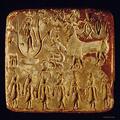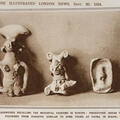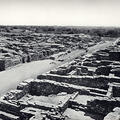Ancient Indus males of stature seem to have had their hair tied in close buns, and with headband to further articulate their head.
344 posts, also carried on our Facebook page, about the ancient Indus Valley civilization, including important news, research and occasional visits to museums with ancient Indus artifacts.
Mar 7, 2015
"The Harappan chimaera was composed of body parts derived from different animals, as well as humans and other fantastic beings of the Indus imagination." Dennys Frenez and Massimo Vidale's article Harappan Chimaeras as ‘Symbolic Hypertexts’. Some Thoughts on
Mar 2, 2015
It is often said that the ancient Indus people invented latrines, as these examples from Harappa and Mohenjo-daro suggest.
Feb 22, 2015
One side of a planoconvex molded tablet found in 1995 in Mound ET at Harappa.
Feb 19, 2015
Planoconvex molded tablet from Harappa showing a deity battling two tigers.
Feb 17, 2015
An unfired steatite seal and sealing of a boat found at Mohenjo-daro. A close and insightful reading by Ernest J.H. Mackay reads "Seal 30 ... was found in two pieces.
Feb 11, 2015
This seal from Mohenjo-daro contains, perhaps more compactly than any other, what we can tell of ancient Indus beliefs and traditions.
Feb 2, 2015
The first Indus women surfaced in the Illustrated London News on September 20, 1924. John Marshall was announcing the discovery of a civilization in India far earlier than Western archaeologists had surmised and these Harappan figurines were earlier than any
Feb 1, 2015
What about the platforms? Another perplexing Indus mystery concerns the so-called workingmen's platforms at Harappa, next to the "granary" whose purpose also eludes us.
Jan 29, 2015
John Marshall writes of what he called First Street, "The northern part of this street, 145 feet in length, had been dug by Mr.
Jan 25, 2015
What was the so-called granary used for? There are twelve rooms in this 50 by 40 meter building. It was built on a giant mud-brick platform between 2200 and 2300 BCE, but there is an earlier building under at least one section.
Jan 22, 2015
A cubical die with 1 to 6 dots was found in rubble during excavations at Harappa between 1995 and 2001. Many dice were also found at Mohenjo-daro, and John Marshall writes: "That dicing was a common game at Mohenjo-daro is proved by the number of pieces that
Jan 19, 2015
The first seal, found at Harappa before 1872. Included in The British Museum's A History of the World in 100 Objects, a nice podcast of the chapter on this black stone unicorn seal is available for free at bbc.co.uk (Episode 16, Indus seal). Sir Alexander
Jan 14, 2015
Ancient Indus food, drink and cooking vessels would likely not be out of place in South Asia today, so familiar are the designs and materials A copper/bronze plate from Mohenjo-daro, terra cotta cooking pots from Nausharo (2200-2300 BCE), a stone (fuchsite) drinking vessel from Mohenjo-daro, and a copper/bronze cooking pot from Harappa.















